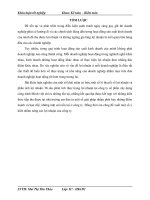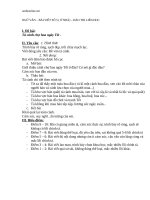Trịnh minh việt đề 2 ngữ âm lý thuyết
Bạn đang xem bản rút gọn của tài liệu. Xem và tải ngay bản đầy đủ của tài liệu tại đây (287.27 KB, 2 trang )
HANOI OPEN UNIVERSITY
ASSIGNMENT ON PHONETICS & PHONOLOGY
E-LEARNING CENTRE
Full name: Viet Trịnh Minh
Date of birth: 16th of November 2021
Group: FHTM114C
Question 1: What have you learnt in the course of phonetics and phonology? What makes you
most interested? Why?
Phonetics and phonology are as physical entities, and how they are perceived and processed by
the ear and brain – phonetics, the study of speech sounds in general, and phonology, the study
of the speech sounds used now and in the past by a specific language or group of related
dialects or languages, provide indispensible information and insight.
Phonetics is particularly useful because you will learn exactly how the sounds of language are
formed, and you will be able to produce them fairly precisely rather than simply using the most
similar sound from your existing repertoire.
For instance, in Spanish voiceless stops are not aspirated as they are in some positions in
English (the puff of air after an initial or final consonant), so an English speaker must learn to
suppress aspiration. In Spanish voiced consonants have a fricative form between vowels: /b/
becomes a [ẞ] in words like bebé [be’ẞe], /d/ is pronounced [ð] (voiced th like in ‘the’) in the
second syllable of dedo [‘deðo], etc. Consonants that are alveolar (coronal) in English (t, d, r, l,
n) tend to be dental in Spanish (tongue against back of front teeth). The /l/ in Spanish is not
palatalized the way it is in American English (back of tongue raised). Vowels are not
automatically glides or diphthongs the way many tend to be in English ([e] vs. [ey]). Each of
these subtle factors will make a difference in how natural your pronunciation sounds
Phonology is also useful but not as essential to the language learner. It deals with how a
language categorizes sounds into phonemes (basic units similar to letters) and how context
affects how the phonemes are realized (as in the examples above). It is helpful for
understanding why the same phoneme sounds different in certain contexts, so you’re not just
parroting what you hear, it makes a bit of sense to you.
Question 2: How does Phonetics & Phonology help you learn other subjects and your career?
Well phonetics will tell you how a sound is pronounced. Phonology will tell you whether it
is relevant or not. Some phonetic differences are distinctive and others are not, depending on the
language. And most times, if you were not exposed to a given language, you will be
phonetically (and possibly phonologically) deaf: you will simply not hear the differences
between sounds. Phonetics can help you understand how to pronounce the sound. But still, it’s
sometimes very tricky. For example, in French we have almost the full paradigm of nasal
vowels (except for central vowels like “eu” from “feu”, or “u” from “pur”). If your language
doesn’t have these vowels, you’re going to have a very hard time distinguishing them and
producing them correctly. And that’s not good: “vin” is not “vent”, “cent” is not “son”.
If you are interested in the physical manifestations of language – how speech sounds are
produced, what they are as physical entities, and how they are perceived and processed by the
ear and brain – phonetics, the study of speech sounds in general, and phonology, the study of
the speech sounds used now and in the past by a specific language or group of related dialects
or languages, provide indispensible information and insight.
I’ve found the study of phonetics very useful in helping me learn the pronunciation of
foreign languages. It’s important to be good at imitating the sounds of a native speaker, but it
also helps to know exactly what they are doing differently from your native language with their
mouths and tongues.
N.B:* -The assignment can be typed or written by hand, then changed into PDF form.
(HANDWRITING IS PLUS)
-Only answers in PDF form are accepted.
-The assignment which is copied or identical to others will be given mark 0.









